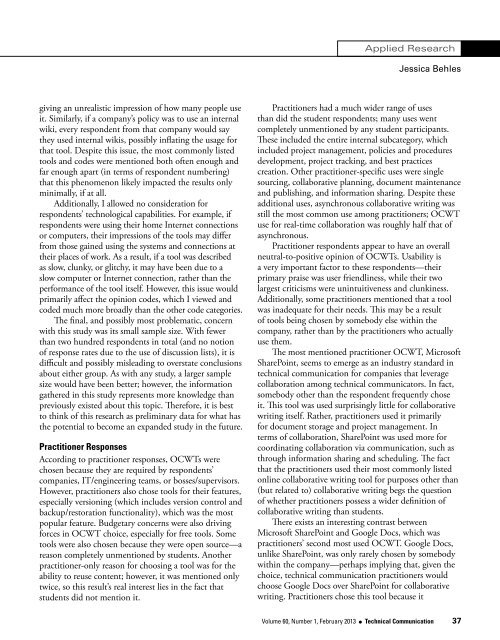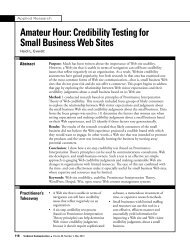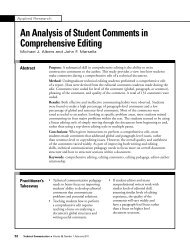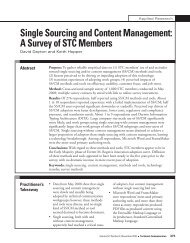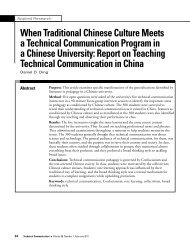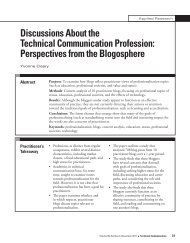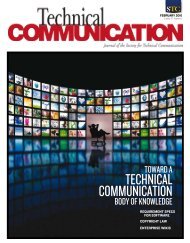The Use of Online Collaborative Writing Tools by Technical ...
The Use of Online Collaborative Writing Tools by Technical ...
The Use of Online Collaborative Writing Tools by Technical ...
You also want an ePaper? Increase the reach of your titles
YUMPU automatically turns print PDFs into web optimized ePapers that Google loves.
Applied ResearchJessica Behlesgiving an unrealistic impression <strong>of</strong> how many people useit. Similarly, if a company’s policy was to use an internalwiki, every respondent from that company would saythey used internal wikis, possibly inflating the usage forthat tool. Despite this issue, the most commonly listedtools and codes were mentioned both <strong>of</strong>ten enough andfar enough apart (in terms <strong>of</strong> respondent numbering)that this phenomenon likely impacted the results onlyminimally, if at all.Additionally, I allowed no consideration forrespondents’ technological capabilities. For example, ifrespondents were using their home Internet connectionsor computers, their impressions <strong>of</strong> the tools may differfrom those gained using the systems and connections attheir places <strong>of</strong> work. As a result, if a tool was describedas slow, clunky, or glitchy, it may have been due to aslow computer or Internet connection, rather than theperformance <strong>of</strong> the tool itself. However, this issue wouldprimarily affect the opinion codes, which I viewed andcoded much more broadly than the other code categories.<strong>The</strong> final, and possibly most problematic, concernwith this study was its small sample size. With fewerthan two hundred respondents in total (and no notion<strong>of</strong> response rates due to the use <strong>of</strong> discussion lists), it isdifficult and possibly misleading to overstate conclusionsabout either group. As with any study, a larger samplesize would have been better; however, the informationgathered in this study represents more knowledge thanpreviously existed about this topic. <strong>The</strong>refore, it is bestto think <strong>of</strong> this research as preliminary data for what hasthe potential to become an expanded study in the future.Practitioner ResponsesAccording to practitioner responses, OCWTs werechosen because they are required <strong>by</strong> respondents’companies, IT/engineering teams, or bosses/supervisors.However, practitioners also chose tools for their features,especially versioning (which includes version control andbackup/restoration functionality), which was the mostpopular feature. Budgetary concerns were also drivingforces in OCWT choice, especially for free tools. Sometools were also chosen because they were open source—areason completely unmentioned <strong>by</strong> students. Anotherpractitioner-only reason for choosing a tool was for theability to reuse content; however, it was mentioned onlytwice, so this result’s real interest lies in the fact thatstudents did not mention it.Practitioners had a much wider range <strong>of</strong> usesthan did the student respondents; many uses wentcompletely unmentioned <strong>by</strong> any student participants.<strong>The</strong>se included the entire internal subcategory, whichincluded project management, policies and proceduresdevelopment, project tracking, and best practicescreation. Other practitioner-specific uses were singlesourcing, collaborative planning, document maintenanceand publishing, and information sharing. Despite theseadditional uses, asynchronous collaborative writing wasstill the most common use among practitioners; OCWTuse for real-time collaboration was roughly half that <strong>of</strong>asynchronous.Practitioner respondents appear to have an overallneutral-to-positive opinion <strong>of</strong> OCWTs. Usability isa very important factor to these respondents—theirprimary praise was user friendliness, while their twolargest criticisms were unintuitiveness and clunkiness.Additionally, some practitioners mentioned that a toolwas inadequate for their needs. This may be a result<strong>of</strong> tools being chosen <strong>by</strong> somebody else within thecompany, rather than <strong>by</strong> the practitioners who actuallyuse them.<strong>The</strong> most mentioned practitioner OCWT, Micros<strong>of</strong>tSharePoint, seems to emerge as an industry standard intechnical communication for companies that leveragecollaboration among technical communicators. In fact,somebody other than the respondent frequently choseit. This tool was used surprisingly little for collaborativewriting itself. Rather, practitioners used it primarilyfor document storage and project management. Interms <strong>of</strong> collaboration, SharePoint was used more forcoordinating collaboration via communication, such asthrough information sharing and scheduling. <strong>The</strong> factthat the practitioners used their most commonly listedonline collaborative writing tool for purposes other than(but related to) collaborative writing begs the question<strong>of</strong> whether practitioners possess a wider definition <strong>of</strong>collaborative writing than students.<strong>The</strong>re exists an interesting contrast betweenMicros<strong>of</strong>t SharePoint and Google Docs, which waspractitioners’ second most used OCWT. Google Docs,unlike SharePoint, was only rarely chosen <strong>by</strong> somebodywithin the company—perhaps implying that, given thechoice, technical communication practitioners wouldchoose Google Docs over SharePoint for collaborativewriting. Practitioners chose this tool because itVolume 60, Number 1, February 2013 l <strong>Technical</strong> Communication 37


